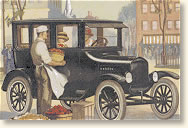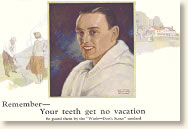Advertising in the 1920s
Advertising as it is known today finds its roots in the industrial expansion
of the 1880s. The mass production and the lowering of prices on consumer goods
meant that more items were available to more people than ever before. The construction
of the transcontinental railroads provided a national market for a company's
goods.
 |
Ford Ad - 1924
Tudor Sedan $590, Sedan $685,
Coupe $525 |
Advertising a product changed from simply announcing the existence of
a product in a dull, dry fashion to persuading the public they needed and deserved
to own the product. By developing repeat customers, advertising also helped build
brand loyalty for the company. Brand loyalty helps sell other existing and new
products to these same customers.
Prior to World War One, muckraking journals like McClure's achieved widespread
circulation by exposing corruption and greed in business and politics. Changes
in print technology in the 1890s and a heavy dependence upon advertisers allowed
publishers to drop their prices from thirty-five cents to a nickel. Readership
for profitable magazines soared from 10,000 readers prior to 1890 to a circulation
of around a half-million. But by 1914, readers grew weary and bored with the
magazines' campaigns for reform. More importantly, advertisers objected strongly
to the investigative articles, which reflected badly on their own kind.
After the war, general circulation magazines dropped the theme of reform and picked up on the culture of consumerism. Ladies' Home Journal and The Saturday Evening Post, featuring Norman Rockwell's paintings on its cover, became fixtures in middle-class homes around the country. Hoping to attract serious newsreaders, Henry Luce began publishing Time in 1923. New tabloid newspapers launched after the war, like the New York Daily News,
 |
Colgate Toothpaste Ad - 1924
$.25 for the large tube |
achieved large circulation by covering crime, sports and scandals. Advertisers,
now reaching millions of consumers on a daily or weekly basis, hired movie stars
and sports figures to persuade Americans to buy all types of products, from coffee
to tobacco products. Business had become America's secular religion, thanks to
advertising. Bruce Barton's 1925 book comparing religion and business, The Man Nobody Knows, declared Jesus Christ's parables as "the most powerful advertisements of all time.... He would be a national advertiser today."
Coca-Cola serves as a good example of how product advertising changed over this forty-year period. When first introduced in the 1880s, the product was marketed as a medicine, with claims that it cured headaches, and that it "revived and sustained" a person. Seeking to build repeat business and brand loyalty, by the 1920s the company emphasized it as a refreshment and a "fun food". Consumers demanding the cola at soda fountains could pressure storeowners to stock it, or risk losing their business. Today Coca-Cola is one of the largest and most visible companies in the world thanks to its successful advertisement campaigns.
References:
Pope, Daniel A, The Making of Modern Advertising (1983); Tedlow, Richard, New and Improves: The Story of Mass Marketing in America (1990).
How To Cite This Article:
"Advertising in the 1920s," EyeWitness to History, www.eyewitnesstohistory.com (2000).
|






